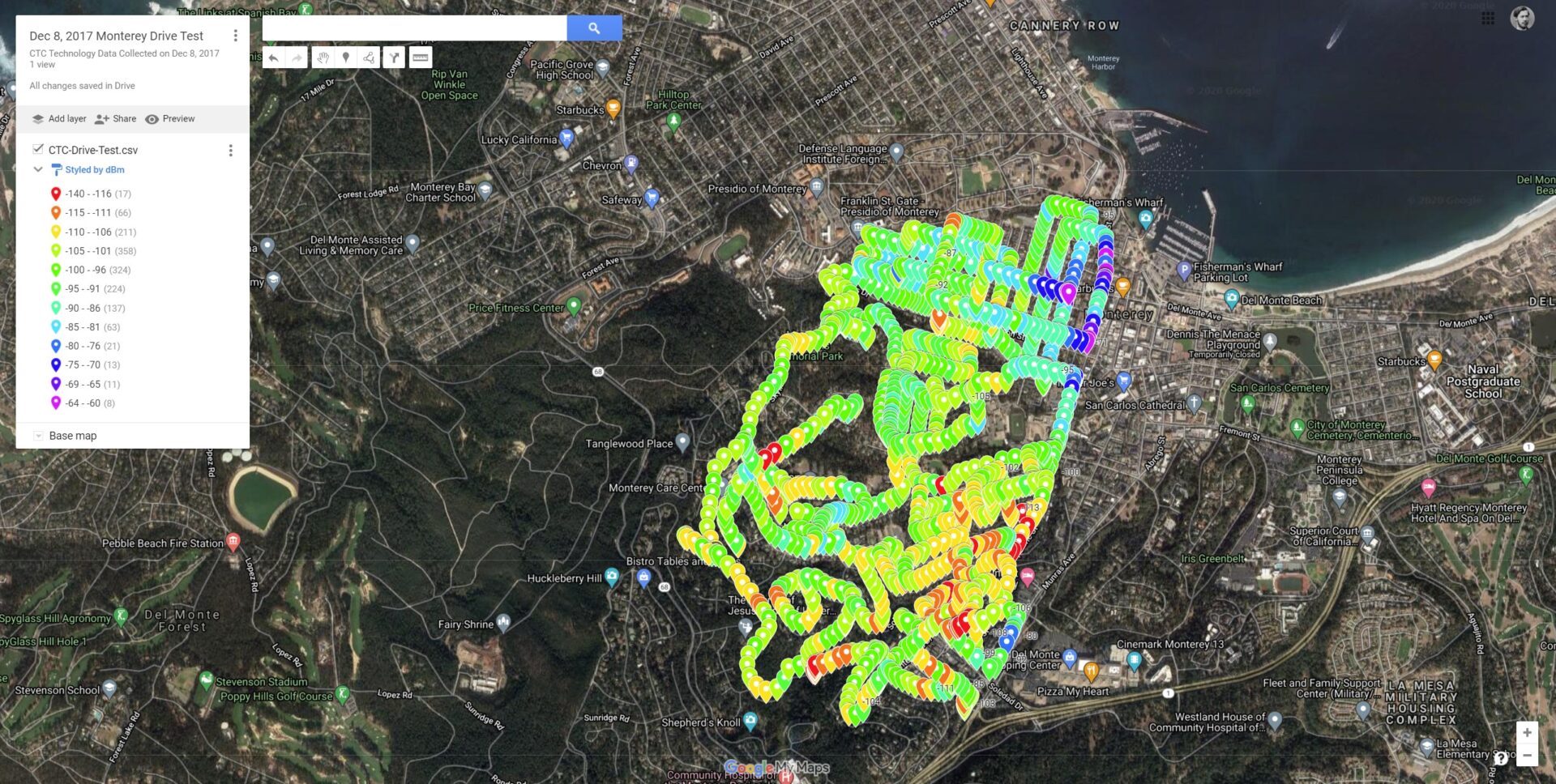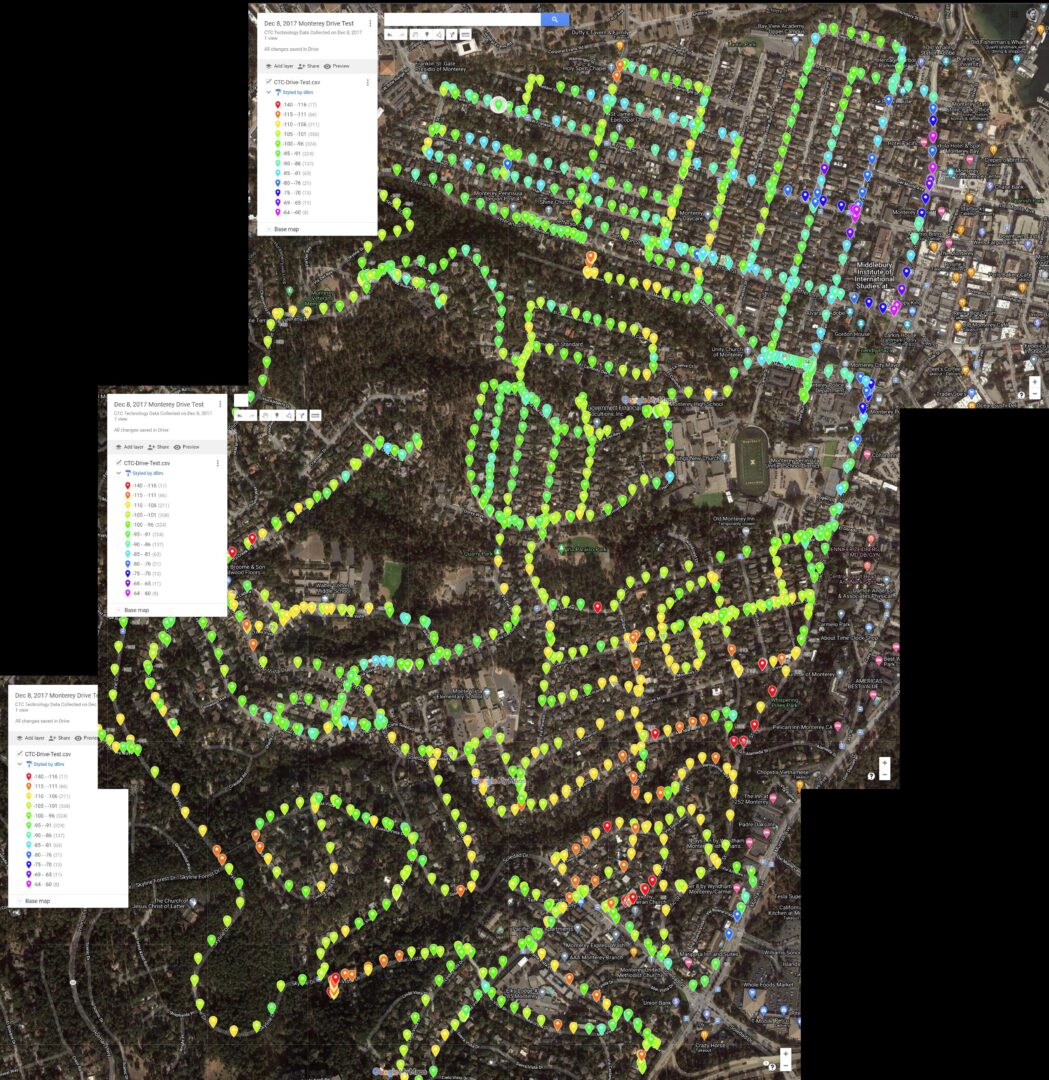ctc technology& energy (engineering & business consulting)
Examination of ExteNet Applications and
On-Site Review of Existing Verizon Service
for Small Cell Node Deployment
for Verizon Wireless Customers
City of Monterey, California
Report Date: December 20, 2017
Data Collection Date: November 8, 2017
Background
CTC is an independent engineering consulting firm with more than 35 years of experience assisting public sector clients with communications engineering, design, and analysis. The principal radio frequency (RF) specialist and licensed professional engineer who completed this review combine for more than 65 years of experience analyzing and field-testing wireless radio frequency signal propagation, including an extensive knowledge of current and cutting-edge antenna systems, towers and all the related hardware equipment required to deliver wireless services. We currently assist numerous municipalities with wireless antenna structure management and review services.
Our wireless engineers and “tower team” have processed more than 5,000 tower- and antennasiting applications for our clients nationwide, giving us insight into the many alternatives available to mitigate the impact of new facilities on a community—as well as an understanding of zoning standards and rights-of-way (ROW) issues that protect the public interest yet permit deployment of new wireless services to benefit residents.
Through our client engagements, we have evaluated applications related to wireless carriers’ voice and broadband deployments. We have wide-ranging experience with conventional macro sites, distributed antenna systems (DAS), and small cell deployments. We have evaluated and advised our public-sector clients on applications from all national carriers and infrastructure providers, including without limitation AT&T, Clearwire, Cricket, Sprint, T-Mobile, Verizon Wireless, Crown Castle, Mobilitie, and others.
In the applications reviewed in this report, ExteNet Systems, Inc., is seeking permission to deploy a network of 13 small cell nodes on existing and replacement vertical infrastructure within the public right-of-way in the City of Monterey, California. This deployment would typically consist of adding an omnidirectional cannister-style antenna on existing or replacement utility poles in the public right-of-way, with associated electronics either mounted on the pole or placed within an adjacent underground vault. (In two of the proposed locations, numbers 12 and 13, an existing marbelite streetlamp would be replaced to accommodate a new antenna on top with internal wiring and undergrounded electronics.) This proposed network of small cell nodes is intended to provide additional wireless service capacity, using the 1900 and 2100 MHz spectrum (licensed to Verizon Wireless) for the mostly residential area approximately bordered by Franklin Street to the north, Pacific Street to the east and Skyline Drive to the west and south.
Site Survey Findings
Exhibit 1 shows the map provided to the City of Monterey by ExteNet to predict the coverage of these 13 small cell nodes, alongside with the existing macro cells in the four corners of the map. These macro cells are the current generation of multiple panel antennas (sometimes camouflaged as flagpoles, trees or as attachments to building tops) which are typically 150-200 feet off the ground and are meant to cover a 1-to-3 square mile area. This means that all the cellphones (and other devices) for that carrier in that area would necessarily connect back to that cell site.
As consumers increasingly adopted smartphones, their demands and use for data increased exponentially and the macro facilities are either too distant from the user device to achieve broadband speeds or generally lack the bandwidth to handle the increased demands from the same service area. As a result, wireless network architecture dependent solely on macro facilities is no longer an efficient solution from an engineering standpoint. Instead, to fully deploy robust 4G and (soon) 5G LTE networks with increased capacity and speed, carriers are investing in small cell deployments across the country. Each small cell node in the deployment typically covers an area of between 800-to-3,000 square feet, depending on antenna selection and terrain. Because these small cell nodes can reuse the same frequencies over and over, and since there are so many (in this case, 13 sites instead of the single macro site), these small cells will accommodate many more users and afford each a significant amount of data throughput at any given time.
Currently, in the area of Monterey proposed by ExteNet for these small cell nodes, there is 4G LTE Verizon Wireless coverage which is almost exclusively being provided by their licensed 700 MHz spectrum. The more recent PCS and AWS Verizon Wireless licenses are in a significantly higher part of the spectrum (1900-to-2100 MHz) and are most effective at a shorter distance and in a line-of-sight (LOS) situation. As a result, these higher frequency signals do not propagate with the same reach and coverage as the 700 MHz coverage from the macro cell sites.
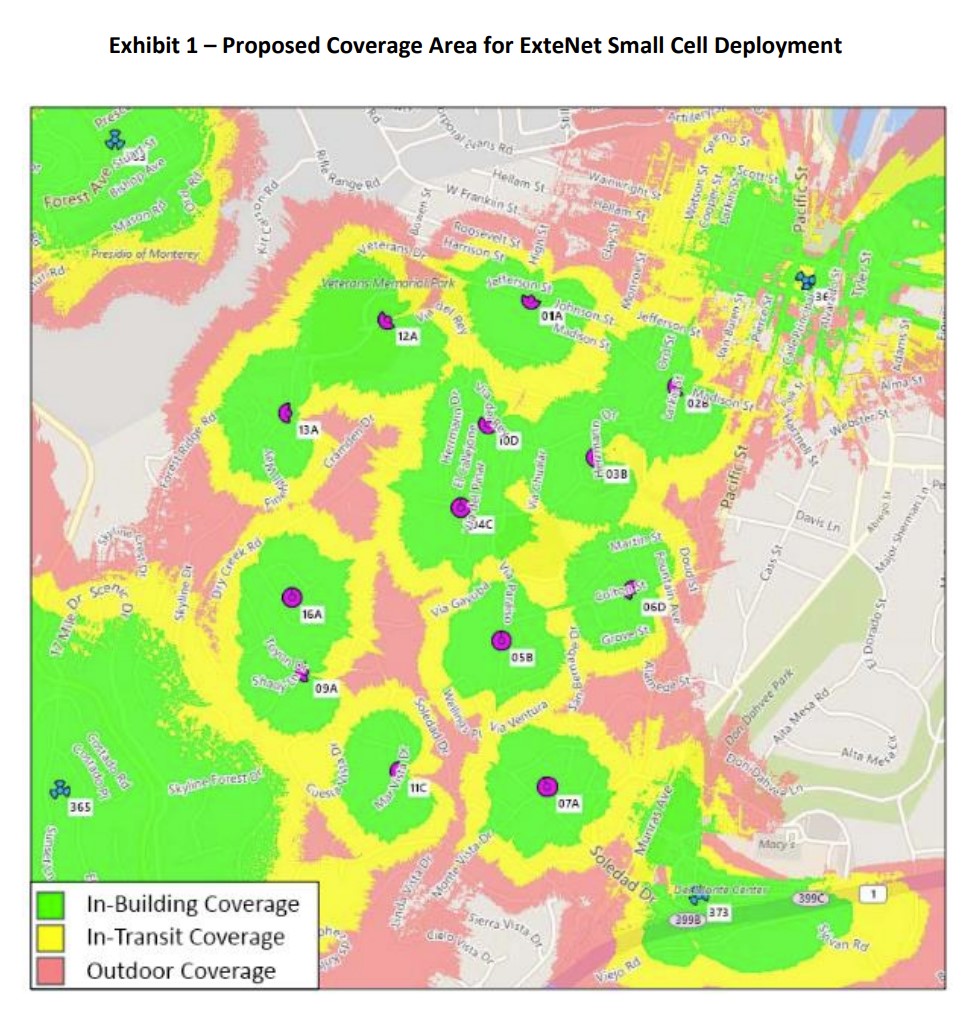
On November 7 and 8, 2017, I undertook extensive field measurements at each proposed small cell node site as well as canvassing the entire proposed coverage area to determine existing Verizon Wireless signal levels. Initially, I visited three of the Verizon Wireless macro sites (downtown on the roof of the Marriott hotel at 350 Calle Principal, a camouflaged flagpole in the shopping center at 1301 Munras Avenue, and a parking lot at 1213 Forest Avenue) to take baseline readings of the existing Verizon Wireless signal strength and perform data throughput (i.e., data speed) tests. These measurements would provide a best-case scenario for gauging the performance of the existing Verizon Wireless network. Exhibit 2 shows the results of the network performance tests at each existing macro site location:
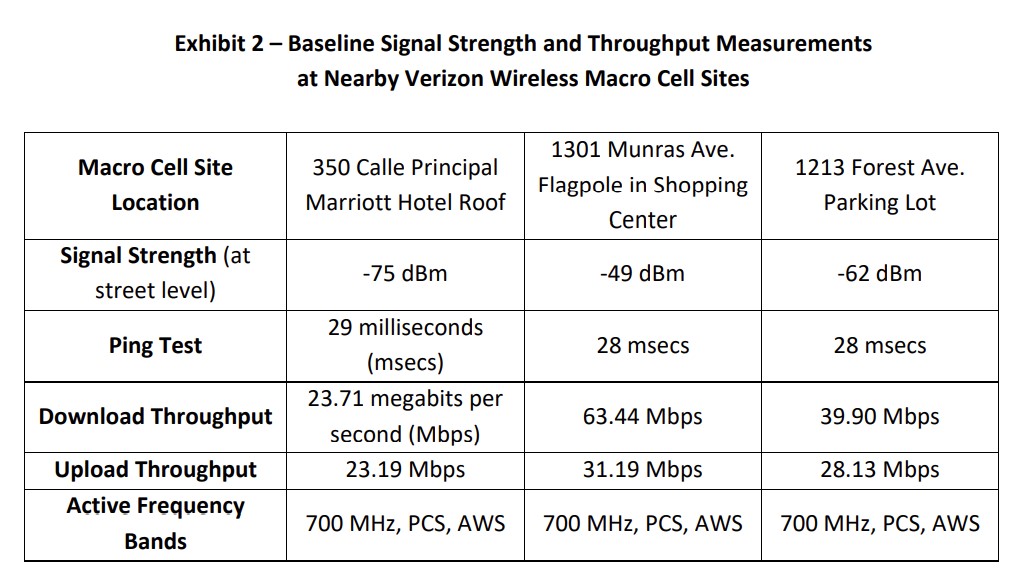
Exhibit 2 – Baseline Signal Strength and Throughput Measurements at Nearby Verizon Wireless Macro Cell Sites
Signal strength is simply a measurement of the signal being received from the cell site, a quantification of what people are accustomed to calling “bars of service”. It is measured in decibels per meter (dBm) and is a negative number. An excellent signal (5 bars) is typically -75 dBm, while a marginal signal (1 bar) would be approximately -105 dBm. Signal strength is largely dependent of the distance of the cellphone from the cell site, as the signal rapidly dissipates as it propagates from the antenna.
The ping test measures (in milliseconds) how long it takes for the cellphone to make a roundtrip from the user’s device to a server on the Internet via the nearest cell tower. The ping test can help determine capacity issues on the cell network since you will be competing with all the other connected cell users for the internet connection. A slower speed indicates a capacity issue with the network. Good ping test times are typically 25-to-45 milliseconds on a mobile wireless broadband network.
Throughput speed tests are conducted in both directions and measured in megabits per second (Mbps). The upload speed indicates the data being pushed from the cellphone into the network while the download speed indicates the data being requested and pulled by the cell phone from the network. See Appendix C for a brief description of how much throughput speed is necessary to support various applications on wireless capable devices.
At each proposed small cell node location, I used a spectrum analyzer (a portable device used to measure radio signals in detail) to verify the frequency band being used and performed signal strength and multiple data throughput speed tests. At all locations, only Verizon Wireless signals in the 700 MHz band were detected. Comprehensive, multi-page reports on each of the proposed 13 small cell node locations are included in Appendix A.
Finally, I conducted an extensive drive test throughout the entire area of the proposed small cell nodes. Signal level measurements were made throughout the area and recorded in a slowly moving vehicle at five second intervals. A standard LG K20V Android-based phone was used to connect to the Verizon Wireless network; the phone was inside the vehicle using its internal antenna. It was also placed in a cradle to maintain uniformity in its location and orientation to the cell tower sites to which it was connected. The data was then plotted using the geographical coordinates on a Google Earth map. This map is included here as Exhibit 3. A complete listing of the 1,452 measurements points used to create this coverage map can be found in Appendix B of this document. The listing includes the measured signal level, the geographical coordinates of the location where the measurement was taken and the existing Verizon Wireless macro site that was connected for service.
I found the Verizon Wireless signal strength levels to vary throughout the area. Roughly speaking, the northern third of the map (mostly in blue and dark blue) had good signal strength readings, the center third of the map showed lower-but-acceptable signal strength (mostly green and lighter blues), and the lower third of the map showed low signal strength for good wireless broadband performance (mostly red and green). However, raw signal strength measurements do not provide a complete picture of the performance of this Verizon Wireless network. There are serious concerns about the long-term viability of this existing wireless network in terms of overall capacity, which shows up in the widely varying ping times and extremely low and/or volatile throughput numbers (especially on the download side) which were documented at each proposed small cell node (detailed in Appendix A).
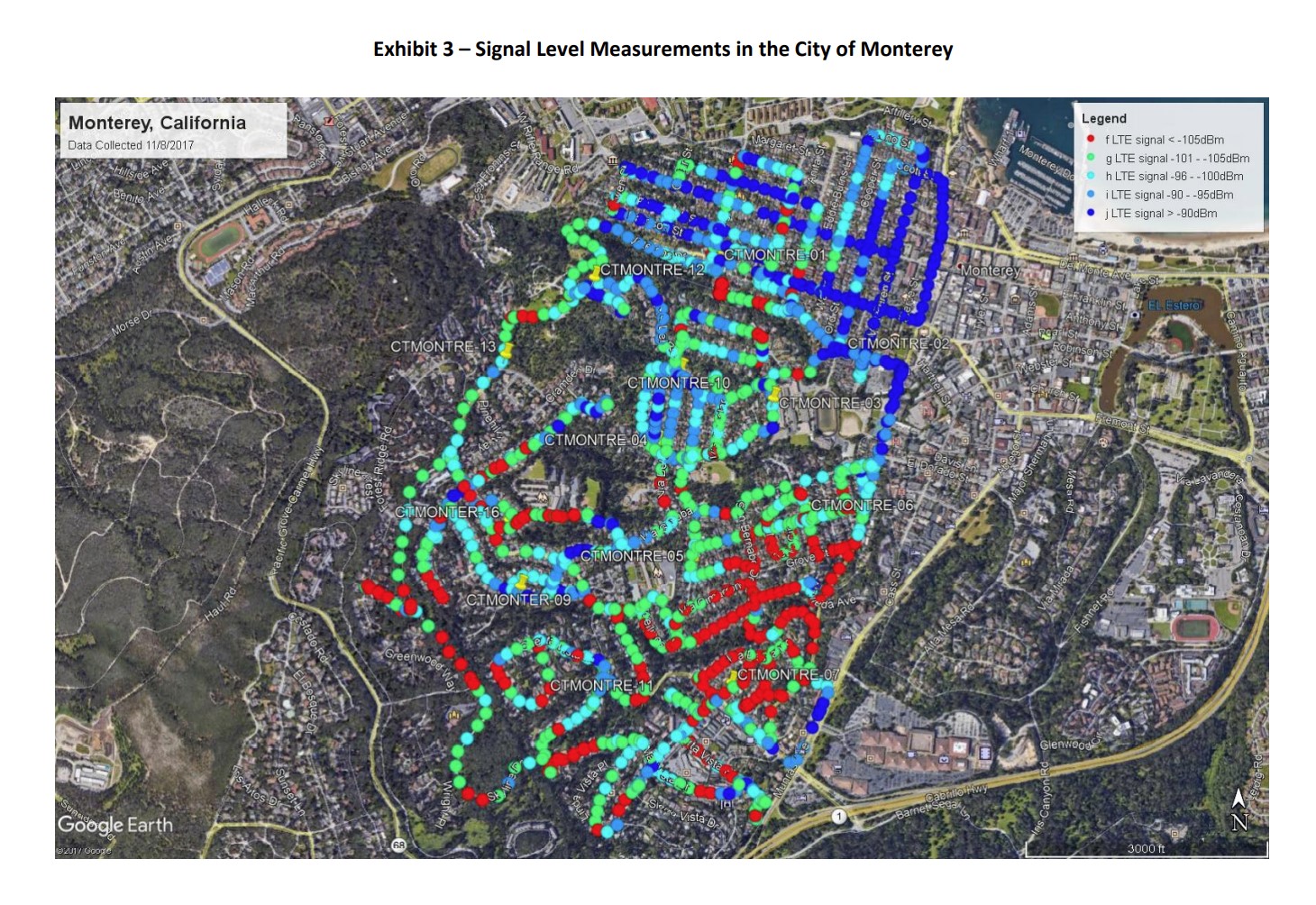
Findings and Conclusions
ExteNet has provided engineering details related to the wireless frequency bands that will be used for the small cell node deployment, including identifying transmitting and diplexing equipment, and specifics regarding the proposed location for equipment and the antenna to be installed.
From an engineering perspective, we have independently examined the areas in which ExteNet proposes to locate the small cell node locations and found that some of the signal levels are lower than we would recommended to support modern 4G LTE customer needs. My experience with 4G LTE networks (consistent with generally accepted industry standards) show that a good in-vehicle or outdoor signal strength measurement should be -95 dBm or greater. Good inbuilding coverage can be found where the signal strength is -85 dBm or higher. The engineering design provided by ExteNet supports that, if these small cell nodes are constructed, they will provide signal level in excess of -95 dBm to support Verizon Wireless customers as well as provide significantly more capacity to Verizon Wireless’ 4G LTE wireless services throughout the target area in the City of Monterey.
Currently from the information obtained in the drive tests, the signal levels were found to vary from less-than -105 dBm (in the southern third of the map) to good and excellent greater than – 90 to -95 dBm (in the top third of the map). I find the proposed target area defined by ExteNet to require additional supplemental service for Verizon Wireless, especially to address insufficient capacity issues, to provide effective broadband Verizon Wireless service.

